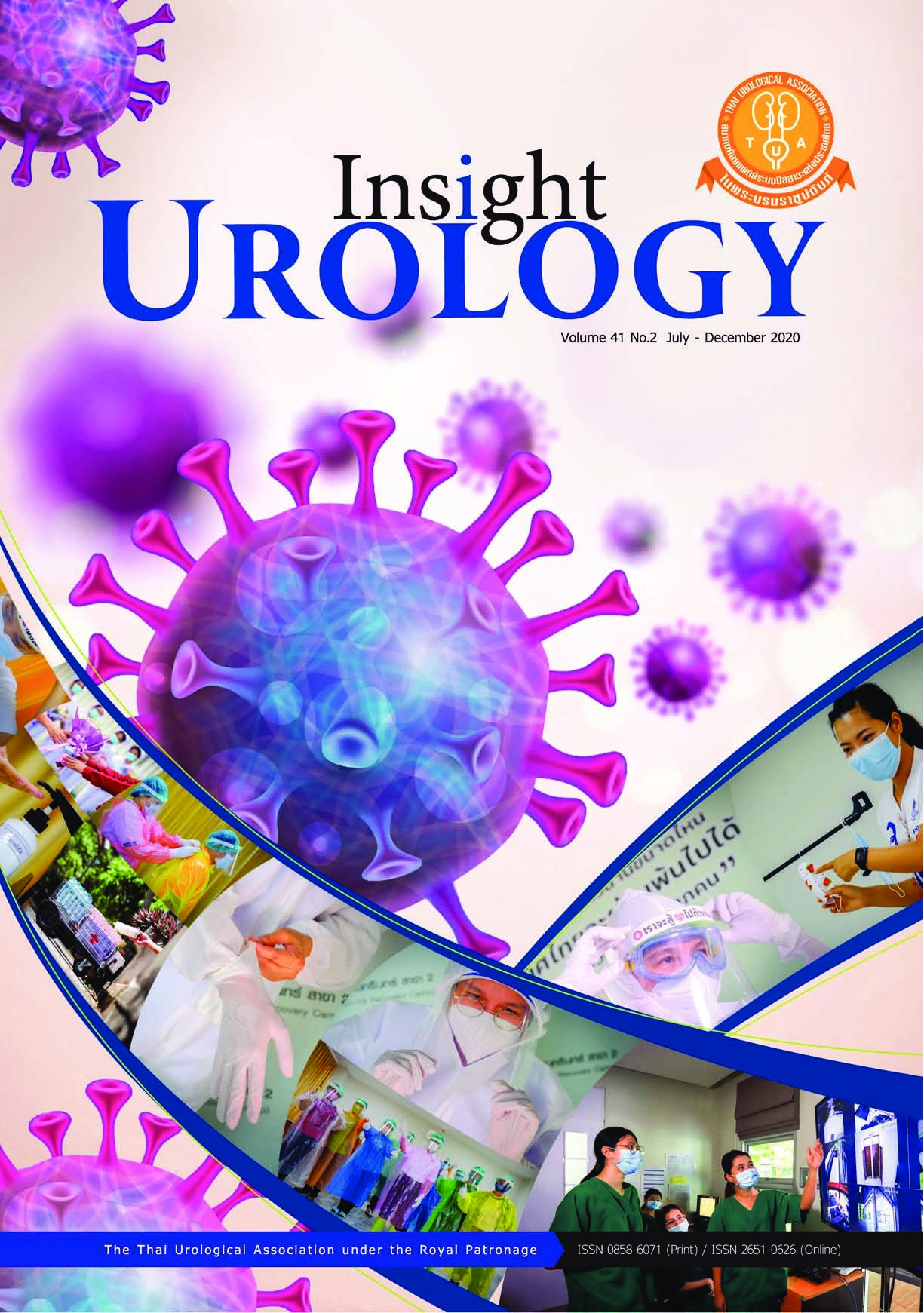Presentation and treatment of arteriovenous fistula, arteriovenous malformation, and pseudoaneurysm of the kidney in Ramathibodi Hospital
Keywords:
Renal arteriovenous fistula, renal arteriovenous malformation, renal pseudoaneurysm, embolizationAbstract
Objective: To review the presentation, predisposing factors, treatment and outcome of renal vascular malformation, including arteriovenous malformation AVM), arteriovenous fistula (AVF) and pseudoaneurysm of the kidney in Ramathibodi Hospital.
Material and Method: In-patient medical records from January 2007 to January 2017 were retrospectively reviewed. Patients admitted and diagnosed with any type of vascular malformation of the kidney, comprising AVM, AVF and pseudoaneurysm in Ramathibodi Hospital were included in the study. Baseline characteristics of the patients, including gender, age at diagnosis, and underlying disease were recorded. Vascular malformation, clinical presentation, imaging data, predisposing factors of the disease, treatment and the outcome of patients were summarized and reported.
Results: Seventeen patients were diagnosed with vascular malformation; 9 patients were males and 8 females. The most common comorbidity was hypertension, followed by chronic kidney disease. Nine patients had AVF (52.94%), 3 had AVM (17.65%), 2 had pseudoaneurysm (11.76%), and 3 had AVF with pseudoaneurysm (17.65%). Common presentations were gross hematuria, flank pain, anemia, and hypovolemic shock. Previous surgery and history of renal biopsy were mutual predisposing factors. Embolization was the most common treatment option. All patients were asymptomatic on follow-up visit with a median follow-up of 90 days.
Conclusion: Vascular malformation of the kidney is not a common condition. The history of previous kidney surgery and renal biopsy may help for diagnostic
suspicion. Renal embolization was the proper management with a high success rate.
References
Cindolo L, Ingrosso M, De Francesco P, Castellan P, Berardinelli F, Fiore F, et al. Giant renal artery aneurysm: A case report. Arch Ital Urol Androl 2015;87:169-70.
Hwang JH, Do YS, Park KB, Chung HH, Park HS, Hyun D. Embolization of Congenital Renal Arteriovenous Malformations Using Ethanol and Coil Depending on Angiographic Types. J Vasc Interv Radiol 2017;28:64-70.
Thayaparan A, Amer T, Mahdi E, Aboumarzouk O, Hughes O. Complete renal artery embolization in a comorbid patient with an arteriovenous malformation. Case Rep Urol 2014;2014:856059.
Ali M, Aziz W, Abbas F. Renal arteriovenous malformation: an unusual cause of recurrent haematuria. BMJ Case Rep 2013;2013.
Dames EL, Ng LG, Tay KH. Congenital renal arteriovenous malformation presenting with gross hematuria after a routine jog: a case report. J Med Case Rep 2014;8:65.
Sountoulides P, Zachos I, Paschalidis K, Asouhidou I, Fotiadou A, Bantis A, et al. Massivehematuria due to a congenital renal arteriovenous malformation mimicking a renal pelvis tumor: a case report. J Med Case Rep 2008;2:144.
Nassiri N, Dudiy Y, Carroccio A, Rosen RJ. Transarterial treatment of congenital renal arteriovenous fistulas. J Vasc Surg 2013;58:1310-15.
Zhang B, Jiang ZB, Huang MS, Zhu KS, Guan SH, Shan H. The role of transarterial embolization in the management of hematuria secondary to congenital renal arteriovenous malformations. Urol Int 2013;91:285-90.
Chimpiri AR, Natarajan B. Renal vascular lesions: diagnosis and endovascular management. Seminars in interventional radiology 2009;26:
-61.
Cho KJ, Stanley JC. Non-neoplastic congenital and acquired renal arteriovenous malformations and fistulas. Radiology 1978;129:333-43.
Rizk GK, Atallah NK, Bridi GI. Renal arteriovenous fistula treated by catheter embolization. Br J Radiol 1973;46:222-4.
Eom HJ, Shin JH, Cho YJ, Nam DH, Ko GY, Yoon HK. Transarterial embolisation of renal arteriovenous malformation: safety and efficacy in 24 patients with follow-up. Clin Radiol 2015;70:1177-84.
Sasaki N, Joashi UC, Vergara M, Saland JM, Love BA. Postrenal biopsy AVM leading to severe hypertension and dilated cardiomyopathy. Pediatr Nephrol 2009;24:2459-62.
Ozdemir S, Cekirge S, Kara A, Bakkaloglu A. A rare complication of renal biopsy in a child with membranoproliferative glomerulonephritis. Int Urol Nephrol 1998;30:689-92.
McDonald P. Arterio-venous fistulae following percutaneous renal biopsy. Australas Radiol 1966;10:124-6.



